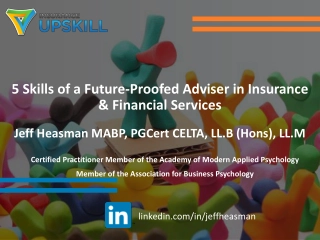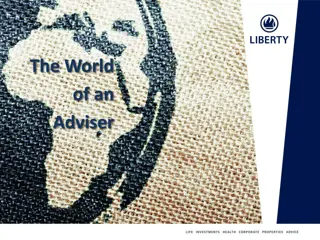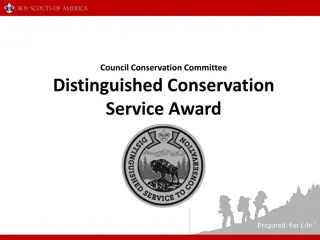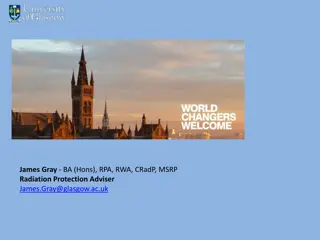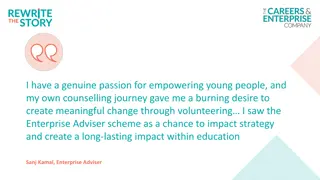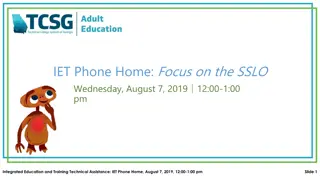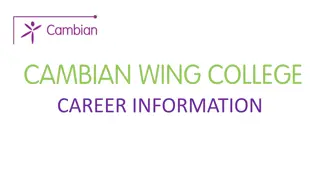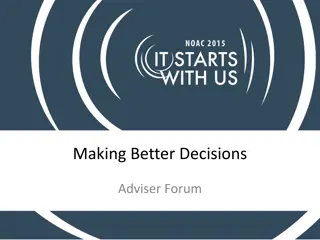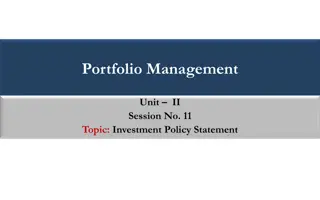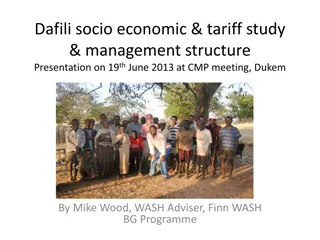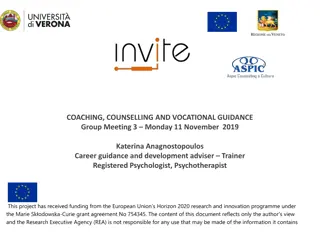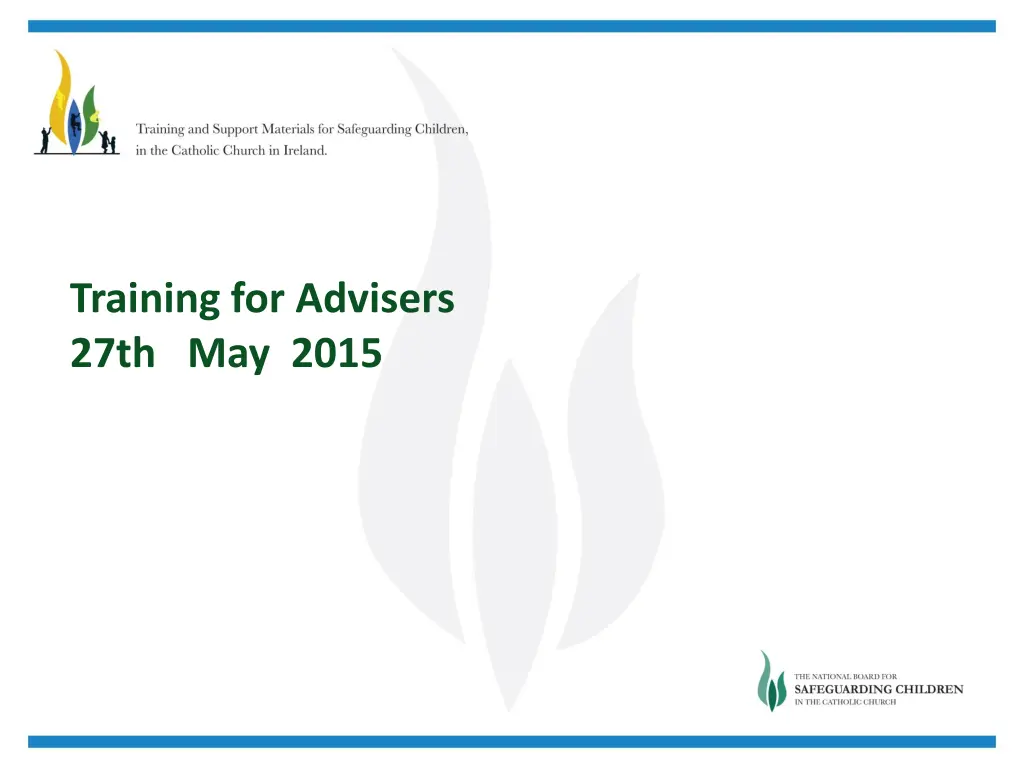
Understanding the Role of Advisers in Safeguarding Children
Join us for a training session on 27th May 2015 to explore the role of advisers in safeguarding children, covering responsibilities, expectations, and standards. Learn about key times, your role, the 7 standards expected, and more to enhance your practice in child safeguarding.
Download Presentation

Please find below an Image/Link to download the presentation.
The content on the website is provided AS IS for your information and personal use only. It may not be sold, licensed, or shared on other websites without obtaining consent from the author. If you encounter any issues during the download, it is possible that the publisher has removed the file from their server.
You are allowed to download the files provided on this website for personal or commercial use, subject to the condition that they are used lawfully. All files are the property of their respective owners.
The content on the website is provided AS IS for your information and personal use only. It may not be sold, licensed, or shared on other websites without obtaining consent from the author.
E N D
Presentation Transcript
Training for Advisers 27th May 2015
Prayer Colette Stevenson
Aims for the Day To identify and discuss your understanding of the role and what excites and challenges you. To identify what we expect the Adviser to do To give you practical experience and advice on how to carry out the role
Key Times Break 11:40 Lunch 13:00 End 15:00
Your Role Your role is: Keeping the respondent informed of the process of the case. Helping direct the respondent to counselling and support. Recording any meetings or contact you have with the respondent, and reporting to DLP as appropriate. Upholding the 7 standards in practice and behaviour.
Your Role Your role isn t: To be a counsellor To be a spiritual director To be the case manager
What is expected: The Seven Standards A written policy for keeping children safe. Written procedures for responding to allegations, suspicions and concerns. Policies and practices to prevent harm to children. Training and education for safeguarding personnel. Clear processes to communicate the Church s child safeguarding policy and procedures. Access to advice and support for victims and perpetrators. A plan to implement and monitor policies and procedures.
The 7 Standards Standard 2 A written procedure for responding to allegations Standard 1 A written policy For keeping children safe Standard 3 Policies and practices to prevent harm to children Standard 7 A plan to implement and monitor the standards Standard 6 Access to advice and support Standard 4 Training and education for safeguarding personnel Standard 5 Communicating the Church s safeguarding messages
The Diocese/Order as part of the Catholic Church in Ireland recognises and upholds the dignity and rights of all children and is committed to ensuring their safety and wellbeing. We value and encourage the participation of children in all activities that enhance their spiritual, physical, emotional, intellectual and social development as children of God. The Church (including clergy, religious, staff, volunteers and representatives) have a shared responsibility to safeguard children through promoting their welfare, health and development in a safe and caring environment which supports their best interests and prevents abuse.
Creating and Maintaining Safe Environments Communicating The Church s Safeguarding Message Procedures for Responding to Child Protection Allegations, Concerns and Suspicions Implementing and Monitoring the Standards Care and Support for the Complainant Training and Support for Keeping Children Safe Care and Management of the Respondent
Care and Management of the Respondent 4.1 The Church Authority has in place appropriately recruited and trained personnel to support the person who is alleged to have abused a child, otherwise known as the respondent. 4.2 The Church Authority has arrangements in place to inform the respondent that an allegation has been received about them and has a procedure for deciding whether an interim management plan needs to be put in place for the respondent 4.3 When civil authority investigations and assessment have been completed, the Church Authority initiates a Preliminary Investigation as provided for in Canon 1717 (1), (2) and (3), if such an investigation is required 4.4 The Church Authority has in place suitable arrangements for the monitoring and supervision of a respondent where it has been deemed that there is a case to answer.
Links to Other Standards Standard 2 and 3 Clearly understand the case management process and the role of the adviser within that Standard 7 The importance of keeping records up to date, to enable the DLP to produce an internal report on standard 2, 4 and 7 for the Church Authority
Why do we safeguard? The Law The United Nations Convention on the Rights of the Child (1989)- recognises children as people with holders of 42 rights which must be respected by the laws of individual countries including the Holy See, Ireland and the United Kingdom. All of the laws which are discussed later are a part of upholding the rights of children and young people.
Why do we safeguard? Key messages from the past Today the welfare of children is of paramount importance, in the past this wasn t always the case. Church-based organisations must be responsible for safeguarding in its widest sense (to ensure safe environments and safe practices for young people) as well as ensuring adequate responses to any apparent or reported concerns.
Why do we safeguard? The Gospel Safeguarding children is a practical living out of the baptismal vocation of every member of the Church to ensure the safety and well-being of those little ones whom the Lord sets before us as those to whom the kingdom of God belongs . (Mt 19:14)
Pope Francis Our generation will show that it can rise to the promise found in each young person when we know how to give them space. This means that we have to create the material and spiritual conditions for their full development; to give them a solid basis on which to build their lives; to guarantee their safety and their education to be everything they can be; to pass on to them lasting values that make life worth living; to give them a transcendent horizon for their thirst for authentic happiness and their creativity for the good; to give them the legacy of a world worthy of human life; and to awaken in them their greatest potential as builders of their own destiny, sharing responsibility for the future of everyone. If we can do all this, we anticipate today the future that enters the world through the window of the young.
The Role and its boundaries Colette Stevenson
Keeping the Respondent Informed It is part of your role to keep the respondent up to date with the process of their case and provide them with appropriate support or counseling. To do this you need to understand the process of case management which you can attend training on. But you should also be kept informed of the case by the DLP through regular meetings.
Keeping the Respondent Informed During your meetings with respondent they may require support: If it s about any form of support that they ask for directly speak to the DLP If you feel in your meetings with them that they require support talk to the DLP for advice on what to do next Its important you document and record these requests and pass to the DLP to put in the case file Refer to Handout
Practical Experience of Being an Adviser Dan O Connor
Support Colette Stevenson
Who needs support? Complainant Respondent Congregation Safeguarding Personnel
What kind of support? Complainant- Towards Healing, Toward Peace, Support Person Respondent- Counselling, Adviser Congregation- Counselling Safeguarding Personnel - Supervision
A definition for the Church An arrangement to discuss your work regularly with another person formally and informally Supervision is designed for you to work together to ensure and develop the efficacy of working situations It will gather the actions and behaviours and feelings about the work, together with the supervisor s reactions, comments and challenges It is a practice that is bounded by an explicit contract that emphasises that the needs of the person being ministered to take priority. It is NOT therapy
How does the Process work? 1. Initially a person is chosen who: You believe you can relate to You believe you can trust and Has the right skills for what you need 2. A contract or written agreement is produced which covers: Costs Frequency of supervision Meeting place Confidentiality
How does the Process work? 3. At The Session Supervisee submits relevant issues that emerged in their work especially issues that were difficult to deal with Supervisor encourages them to look at other possible ways of responding What was happening to supervisee as they worked? What was the relationship like? Targets are set for the next session 4. Periodic Review Set milestones are agreed when the supervision process will be evaluated
Challenges How is it resourced? How is confidentiality maintained? Difficulty in trust How are objectives set and achieved? How do you convert what is said in supervision to actions?
What to Record During your meetings with the respondent a number of issues may come up, you should record: Dates times and locations of meetings Any requests for support Any additional information with regards the case Refer to Handout

